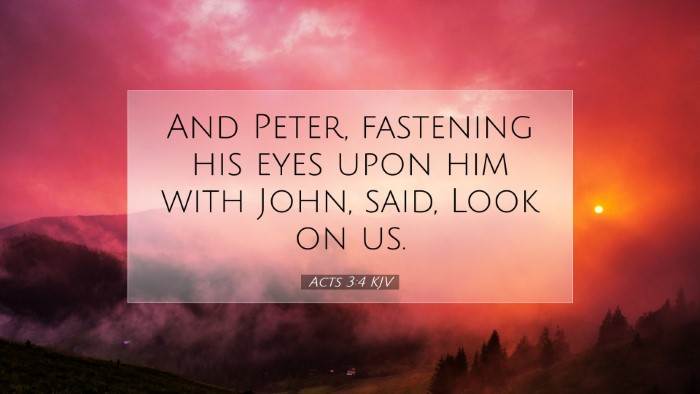Old Testament
Genesis Exodus Leviticus Numbers Deuteronomy Joshua Judges Ruth 1 Samuel 2 Samuel 1 Kings 2 Kings 1 Chronicles 2 Chronicles Ezra Nehemiah Esther Job Psalms Proverbs Ecclesiastes Song of Solomon Isaiah Jeremiah Lamentations Ezekiel Daniel Hosea Joel Amos Obadiah Jonah Micah Nahum Habakkuk Zephaniah Haggai Zechariah MalachiActs 3:4
Acts 3:4 KJV
And Peter, fastening his eyes upon him with John, said, Look on us.
Acts 3:4 Bible Commentary
Commentary on Acts 3:4
Verse Context: Acts 3:4 states, "And Peter, fastening his eyes upon him with John, said, Look on us." This verse occurs in a pivotal moment following the Pentecost and the early establishment of the Church, focusing on the miraculous healing of the lame man at the Beautiful Gate.
Insights from Matthew Henry
Matthew Henry's Commentary emphasizes the authority and power of the apostles as they perform acts of healing, which serve as signs of the authenticity of their ministry. He points out that Peter’s command to the beggar to "look on us" implies a strong expectation of a response, inviting the man to witness the power of God through their ministry.
- Expectancy of Faith: Henry notes that the apostles exhibit a confidence rooted in faith. Peter and John are not providing mere alms; they are offering a transformation that comes only through Christ.
- Focus on the Giver: The phrase “Look on us” indicates the importance of directing the attention of the afflicted toward the apostles, but ultimately toward God. This serves as an important principle for ministry: pointing people to God rather than merely offering physical aid.
Insights from Albert Barnes
Albert Barnes' Notes on the New Testament highlight the significance of Peter's command as both a physical and spiritual invitation. By asking the beggar to look at them, Peter establishes a direct interaction, which not only captures the man's attention but also lays the groundwork for the extraordinary miracle that follows.
- Direct Appeal: Barnes believes that the action demonstrates a form of divine authority. The request for the man's focus symbolizes a moment where he is called to engage with the faith community, fostering an environment ripe for belief and healing.
- Symbol of Expectation: This interaction serves to elevate expectation. Barnes argues that this moment is not merely about physical healing but communicates a deeper spiritual truth—encouraging those in need to anticipate divine intervention.
Insights from Adam Clarke
Adam Clarke's Commentary provides a thorough examination of the societal implications of this interaction. Clarke discusses the background of the lame man, touching upon how societal perceptions of worth and value can be deeply affected by physical limitations.
- Cultural Context: Clarke notes that the lame man, being at the gate, represents those marginalized by society. Peter’s command to "look on us" flips the narrative, suggesting that despite his condition, he is seen and valued in the eyes of God.
- Divine Appointment: He also emphasizes the divine orchestration behind this moment. The healing miracle not only addresses the physical condition of the man but serves as an evangelistic opportunity for the budding Church, as others witness this profound act of compassion.
Theological Reflections
In reflection on Acts 3:4, the theological implications are vast and warrant careful consideration:
- Faith and Healing: The text invites inquiry into the relationship between faith and healing. It is significant that the apostles place themselves in a position of visibility, suggesting that acts of faith can lead to extraordinary change.
- Community and Empowerment: The interaction between Peter, John, and the lame man serves to highlight the role of community within the Church. It is a call for believers to engage with, uplift, and empower those in need.
- Divine Sovereignty: The passage points to God’s overarching control and readiness to act in response to human need, underscoring that God’s power is made manifest through the faithful actions of believers.
Practical Application
For pastors, students, and theologians, Acts 3:4 offers several practical applications:
- Engage with the marginalized: As representatives of Christ, believers are called to actively engage with those who are often overlooked—encouraging the Church to demonstrate compassion and to foster connections with all individuals.
- Encouraging Faith: Like Peter, Christians should foster an environment of expectation where miracles can happen, whether in physical healing or spiritual growth, through an active faith rooted in Christ.
- Sharing God’s Power: This verse encourages the faithful to share the testimony of God’s power in their lives, providing a clear narrative of God’s work through the Church to a world in desperate need of hope.
Conclusion
Acts 3:4 encapsulates a moment of divine interaction, power, and community engagement that reverberates through the theological themes of healing, faith, and divine mercy. Through examining the insights from various commentators, one can appreciate the depth of this singular moment, as well as its implications for the Church today.


